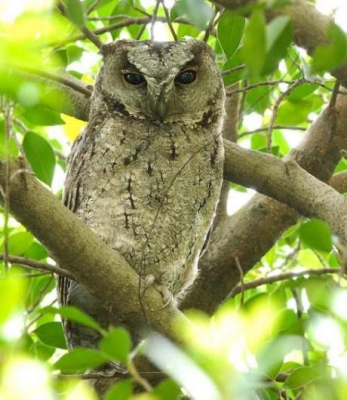
The Indian scops owl, or Otus bakkamoena, is a small-sized owl which belongs to the family Strigidae. It is a resident species native to South Asia and ranges from India, Pakistan, Nepal and Iran. It is similar to the collared scops owl but can be distinguished by its call. Its call is a soft single note, ‘whuk’ while the collared scops owl has a longer ‘gook-gook’.
It has gray or brown upper parts which are faintly spotted. The underparts have fine, dark streaks and its legs are feathered grayish-brown or white up to the base of its toes. Its toes are brown or greenish-yellow with pale brown talons. It has small ear tufts and dark brown or orange-coloured eyes. Its colouring allows it to blend with the background and it can generally camouflage itself much better than other owls.
It prefers to hunt during the night and spends the day sleeping in hollow trees. Its camouflage makes it very difficult to spot. It feeds mainly on insects including beetles and grasshoppers and will occasionally eat lizards, mice and small birds. It prefers forests and groups of densely foliaged trees in gardens, mango orchards and fruit trees around villages and cultivations. It is found mainly in lowlands.
This owl lays about 3 or 4 eggs and its incubation period lasts 28 to 29 days. The owlets take about 21 to 25 days to become fledglings (or ready to fly). The Indian scops owl is not endangered and has a stable population. It is listed under ‘Least Concern’ in the IUCN Red List.
Picture Credit : Google




